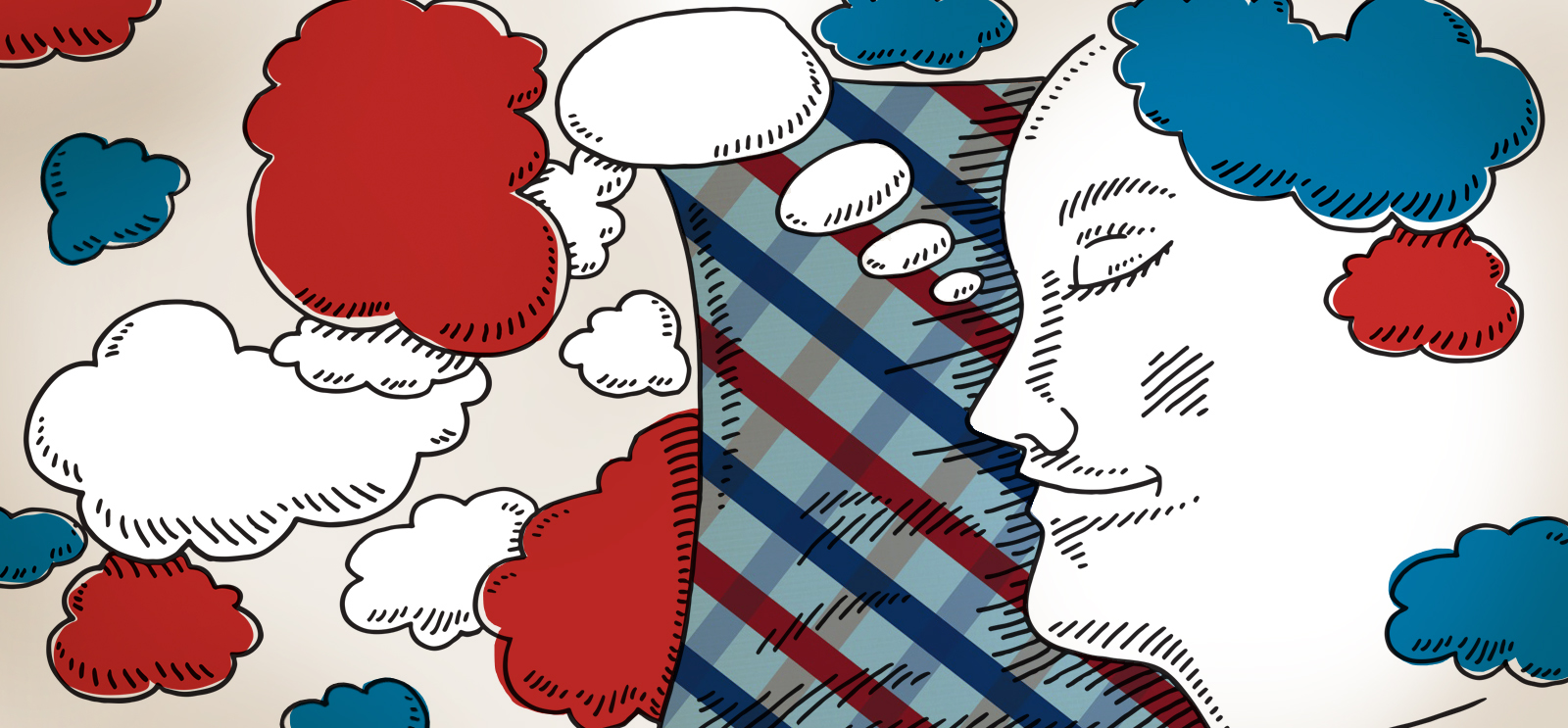
One of Bulkeley’s subjects dreamed of dancing the tango with Donald Trump. (Illustration based on art by ©istock.com/Frank Ramspott)
Kelly Bulkeley, PhD’92, examines what our dreams reveal about our religion, our culture, and our politics.
Earlier this year, Kelly Bulkeley, PhD’92, began collecting dreams about presidential contenders Hillary Clinton and Donald Trump. So far the dreams he has gathered about Clinton tend to be straightforward and low key, where “people feel a connection with her, or talk with her,” says Bulkeley, similar to what they were in 2008.
Trump dreams have been far more numerous—and “all over the map.” In some, the dreamers reported being surprised at how nice he was, or were drawn to a bold move he made. Others have been nightmares, where dreamers are “upset or frustrated by things that he’s doing, or he’s attacking them, or he’s attacking someone else,” he says. Trump is clearly “pushing people’s dream buttons.”
Bulkeley has analyzed Americans’ political dreams during every presidential election cycle since 1992, when he was a doctoral student at the Divinity School. At that time, he was focusing on the work of Sigmund Freud, Carl Jung, and other 20th‑century psychologists who were “pretty adamant that dreams were just about personal, individual issues and concerns and have no relevance to bigger social and collective concerns.” Bulkeley was skeptical.
It happened to be an election year, so he set up a small study. The results were encouraging—Bill Clinton, Ross Perot, and George H. W. Bush all appeared in the study subjects’ dreams in ways that reflected both the dreamers’ political leanings and general post-election analyses. The dreams’ content largely revolved around personal concerns, but the candidates showed up in consistent guises—Clinton as change, Perot as anxiety. (Bush, who was widely seen as unable to connect well with voters, appeared the least often in subjects’ dreams.)
Currently a visiting scholar at the Graduate Theological Union in Berkeley, California, and senior editor of the American Psychological Association’s journal Dreaming, Bulkeley publishes articles and blog posts on presidential dreams every four years. He’s also written a book about political dreams, American Dreamers (Beacon Press, 2008). It’s a good way to “illustrate this bigger point about the cultural dimension to dreaming for a contemporary American audience” for whom dream research may seem too New Age, he says. But the bulk of his work over the past 25 years draws on neuroscience, evolutionary biology, anthropology, and psychology to connect dreaming with other cultural beliefs, particularly religion.
His most recent book, Big Dreams: The Science of Dreaming and the Origins of Religion (Oxford University Press, 2016), focuses on what Jung called “big dreams”—our most visceral and memorable. These include dreams of flying and falling, of sexual encounters, and of being attacked. Big dreams have a physiological response and an evolutionary explanation (like how being attacked in a dream may be our body’s way of helping us prepare for a real-life fight). They’re also the ones that leave a psychological impact long after waking.
Big dreams are found in many religious texts and cultural lore, from prophetic visions to possessions to divine visitations. The physical effects are part of our sleep cycles; the dreams themselves “create an understanding of those [physiological] experiences,” says Bulkeley. For example, some sexually violent dreams are accompanied by temporary sleep paralysis; they likely played a role in generating stories of physically overpowering demonic seduction, from the incubus or succubus of European folklore to the “old hag” that haunted early Newfoundland settlers. To Bulkeley, dreams like these are a “primal wellspring of religious experience.”
Many of the big dreams analyzed in the book came from Bulkeley’s online Sleep and Dream Database. Launched in 2009, the open and searchable database now has more than 20,000 dream reports. Culled from Bulkeley’s own studies and surveys as well as from other scientific and historical sources, the reports are matched with dreamers’ sleep patterns and demographics.
Early in his career, Bulkeley was skeptical of quantitative dream analysis, which uses text analysis and similar tools to dissect dreams. “It seemed to sap the dreams of any lived meaning and organic gestalt qualities.” Now he has found that in addition to providing a trove of dreams to analyze, the database allows research that extends to data-driven observations, adding weight to his arguments and exposing new themes and motifs. He’s found that women and political liberals have higher rates of dream recall, that lucid dreaming (in which the dreamer is aware he or she is dreaming) is relatively widespread, that children dream more about animals, and that Americans dream a lot about cars.
Bulkeley is finishing a study on how political views on immigration affect Americans’ dreams. He’ll continue to collect dreams about presidential candidates up until the election and maybe afterward. “It will be interesting, whether or not he wins, to see if the Trump dreams fade,” he says, “or if his vivid and controversial character becomes a regular part of the American dreamscape.”
